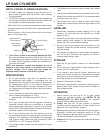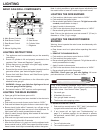Special offers from our partners!

Find Replacement BBQ Parts for 20,308 Models. Repair your BBQ today.

4
OVERFILL PREVENTION DEVICE
1. The standard for outdoor gas appliances, ANSI Z21.58/
CAN/CGA-1.6, requires that appliances be used with
cylinders equipped with an Overfill Prevention Device
(OPD).
2. The OPD is designed to reduce the potential for the
overfilling of propane cylinders, thus reducing the possibility
of relief valve discharges of raw propane. The OPD
causes a slower purge/fi ll operation. Some consumers
have been advised by filling stations that these cylinders
are “defective.” This is not a defect. Some propane filling
stations may not be aware of this device and its effect on
the purge/fill operation.
3. New OPDs coming onto the market have technology that
allows for much greater BTU outputs which will decrease
the amount of time it takes to purge a cylinder.
IDENTIFICATION
To identify these cylinders, the OPD handwheel has been
standardized to the shape shown.
1. All models are equipped with a hose and regulator with a
QCC®-1 Quick Closing Coupling.
2. The QCC® coupling contains a magnetic Flow Limiting
Device which will limit the flow of gas should there be a
leak between the regulator and the appliance valve. This
device will activate if the cylinder valve is opened while
the appliance valves are open. Be sure the appliance
valves are off before the cylinder valve is opened to
prevent accidental activation.
3. The QCC® coupling incorporates a heat sensitive hand
wheel that will cause the back check module in the QCC®
cylinder valve to close when exposed to temperatures
between 240° and 300°F. Should this occur, do not attempt
to reconnect the hand wheel. Remove hose/regulator
assembly and replace with a new one.
4. The pressure regulator is set at 11 inches WC (water
column) and is for use with LP gas only. The hose and
hose couplings comply with CGA Standard CAN 1.83. No
modifications or substitutions should be attempted.
5. Protect the hose from dripping grease and do not allow
the hose to touch any hot surface, including the base
casting of the barbecue.
6. Inspect the seal in the QCC® cylinder valve when
replacing the LP gas cylinder or once per year whichever
is more frequent. Replace the seal if there is any indication
of cracks, creases, or abrasion.
7. Inspect the hose before each use. If the hose is cracked,
cut, abraded or damaged in any way, the appliance must
not be operated.
8. For repair or replacement of the hose/regulator assembly,
contact customer service.
CONNECTION
1. Be sure cylinder valve and appliance valves are “OFF.”
2. Place full LP gas cylinder in LP tank well and secure base
as per assembly instructions.
3. Center the nipple in the cylinder valve and hold in place.
Using other hand, turn the hand wheel clockwise until
there is a positive stop. Do not use tools. Hand tighten
only. When making the connection, hold the regulator
in a parallel with the cylinder valve, so as not to cross
thread the connection.
4. Leak test connections. See “Leak Testing.” (page 5)
5. Refer to lighting instructions. To avoid activating the
Flow Limiting Device when lighting, open cylinder
valve slowly with the appliance valves off. If the Flow
Limiting Device is accidentally activated, turn off cylinder
valve and appliance valves, wait 10 seconds to allow the
device to reset, open cylinder valve slowly, then open the
appliance valve.
DISCONNECTION
Always close LP cylinder valve and remove coupling nut before
moving cylinder from specified operation position.
OPD EQUIPPED CYLINDER HOSE & REGULATOR


















